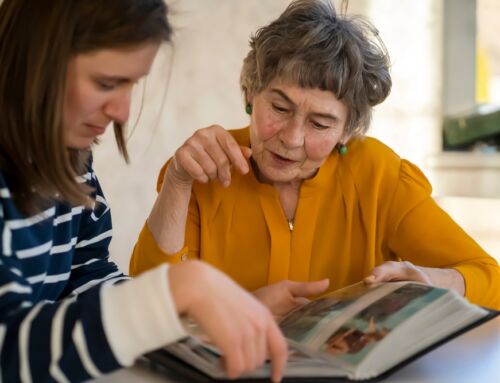I know that it’s only within the last 10 years or so that the term “aging in place” has become part of the vernacular, driven in large part by countless industry articles and surveys showing that upwards of 90 percent of seniors say they want to stay in their home for as long as possible.
This common mindset among a majority of seniors is further bolstered by technology advancements, which helps address some obstacles of remaining in the home, and the homebuilding industry, which has found a niche in building or remodeling homes that are “senior-friendly.” So, I may be going out on a limb with this one, but please use your imagination to journey with me for a moment…
Is it farfetched to even suggest that the day may come when society looks at the concept of “aging in place” as the least desirable option for older adults? I don’t think it is as farfetched as some may think. In fact, a few preliminary observations suggest that we may already be heading in that direction.
A notable shift in the numbers
When I founded myLifeSite nearly eight years ago, one of the most popular statistics about aging in place came from AARP, which in 2014, said that nearly 90 percent of people age 65 and older wanted to stay in their homes as they age. Yet, this 2014 survey also showed that among the next wave of retirees (those who, at the time, were between the ages of 50 and 64), only 71 percent felt the same way. This latter group is now moving into their seventies, a phase of retirement in which seniors begin to focus on and ultimately select their retirement housing options. And AARP’s most recent 2018 survey of adults age 50 and over reveals that only 76 percent want to remain in their homes as long as possible.
These surveys suggest that over the next 10 to 20 years, retirees may be more inclined to seek out senior living options other than their current home. The AARP reports do not get into reasons for this shift in preferences, but I have a few thoughts about what may be driving this, which I’ve been talking about in many of my public presentations over the past few years.
>> Related: 3 Reasons Why Aging in Place May Not Be Cheaper
The reasons behind changing preferences
First, we are facing in our country what is often referred to as a “caregiver crisis.” Some of us will never require long-term care, but most of us will, and often for an extended period of time. In previous blog posts, I’ve referenced studies showing that due to the rapid growth of our senior population, we’ll need over a million more direct care providers in just the next few years.
But just last week, a new report from the Paraprofessional Healthcare Institute (PHI) was released showing the caregiver shortage in our country may be closer to 8 million by the year 2026! This figure factors in not only the estimated 1.4 million new caregivers needed, but also the replacement of caregivers leaving the labor force or changing careers. Unfortunately, filling all or even most of these jobs may not be possible under the current model, which likely means it will become increasingly difficult for those in their home to find and keep a high-quality care provider if care is ever needed.
A recent article in U.S. News and World Report this week highlights the challenges facing the caregiving industry, which primarily comes down to the fact that the caregiver workforce is overworked and underpaid, which leads to very high turnover. You can read the article here to learn more about why so many caregivers are living on poverty-level wages and the obstacles to higher wages, and why consistency is so important when it comes to receiving the care someone deserves.
>> Related: A Low-Wage Paradox for Assisted Living & LTC Caregivers
Family caregivers being stretched thin
Yet, the caregiver crisis doesn’t end with the caregiving industry. There also are going to be far fewer family members available to provide care for older adults due to trends of higher divorce rates and smaller family sizes.
As of today, however, most care provided in the home is provided by family members—often called “informal caregivers.” While there are positive aspects to caring for a loved one, and many people view the role as their duty and privilege, statistics abound regarding the negative effects on health and finances that family caregivers often experience. Actor Rob Lowe recently wrote an article describing the experience of caring for his mother and how incredibly difficult this task can be.
Caring for an aging or ill loved one inevitably takes a toll—emotionally, physically, and even financially. In fact, the expense saved by not hiring paid caregivers often gets transferred to family caregivers in the form of lost wages and lifetime employment benefits (such as 401(k) contributions or lower Social Security). Recognizing this fact, 60 percent of people over the age of 65 say they don’t want to be a burden on their family.
>> Related: The Unexpected Costs of Caring for an Aging Parent
A shift to focus on wellness
While the caregiving piece is an important consideration, it is only one reason why I believe aging in place will become less desirable in the future. In my visits to hundreds of continuing care retirement communities (CCRCs, or life plan communities) across to country over the last few years, it is clear to me that there is a transformation taking place that can benefit residents today (well-before they need care), and perhaps prevent or limit caregiving needs in the future.
In these communities, the focus is rapidly shifting from reactive healthcare to preventive wellness. While residents of CCRCs take great comfort in knowing a continuum of healthcare services is available onsite if needed, the growing emphasis on socialization and other aspects of wellness is designed to help delay or prevent such care services from being needed.
>> Related: Senior Wellness Programs: Good for CCRC Residents & The Bottom Line
As I describe in my book, What’s the Deal with Retirement Communities?, I believe we’ll see a growing number of CCRCs providing primary care on-site or having an on-site physician who knows the residents and can help monitor certain health conditions—hopefully to prevent unnecessary illnesses and hospital admissions.
There are many facets to wellness, which are especially important for older adults, including social, intellectual, spiritual, physical, vocational, and emotional. The best retirement communities today are providing opportunities and programs to help residents optimize each of these areas of wellness in their lives.
Furthermore, many of these programs are led by the residents themselves, which is self-fulfilling in that it feeds right back into aspects such as social and vocational wellness. Rather than the CCRC’s staff leading “planned activities,” which are typically associated with assisted living, the most vibrant communities will shift more towards providing resources and support to help residents plan their own programs and activities.
I can see retirement communities of the future becoming viewed almost as residential wellness communities. As many retirement communities are fond of saying, “People don’t come here to die, they come here to live.”
>> Related: New Study Shows CCRC Residents ARE Happier and Healthier
The importance of interpersonal relationships
Finally, the social component of wellness should never be discounted. When I ask residents of CCRCs what they like most about the community in which they live, the most popular answer I get is “the people…the relationships we’ve developed.” These relationships are important not just for today, but perhaps also so if health declines because there is a built-in support network of close relationships.
As referenced in this New York Times article, studies clearly show that one of the most important aspects to staying healthy longer is experiencing meaningful social interactions on a regular basis. I agree with my friend Harvey Austin, MD, who believes that humans have a deep yearning for living in community.
Am I suggesting that a person cannot age in place and still maintain a healthy and happy life? Of course not, even though for many, it may be more difficult to do so as they age. Home modifications and new technology solutions will help make aging in place safer and easier, but they don’t eliminate many other issues that are associated with this senior living choice.
Remaining in the home too often leads to a gradual slide towards inactivity, increased TV time, fewer social interactions, and a poor diet. A sedentary and increasingly isolated lifestyle can result in physical and mental health issues for many seniors, as well as a marked decline in quality of life.
>> Related: The Key Difference Between Social Isolation & Loneliness
Weighing your senior living options
More and more seniors are recognizing the challenges that come with aging in place and the benefits of living in a CCRC or other senior living community.
While remaining in the home may seem like the best and least expensive solution on the surface, the realities of finding adequate care if and when it is needed—either from paid professional caregivers or unpaid family members—can make this option much less appealing. Add to this the health risks and quality of life issues associated with isolation and inactivity, which is often associated with staying in the home—and the lifestyle offered by a CCRC become much more enticing.
As with any business, there are some CCRCs that do a better job than others. It is important that prospective residents do their due diligence and find a community in which they feel most comfortable. Furthermore, the industry needs to continue its work towards finding ways to offer the same benefits to retirees further down the wealth spectrum, and further innovate around physical designs of the community. But for the communities who do these things, while embracing wellness and resident involvement, —the future is very bright.






